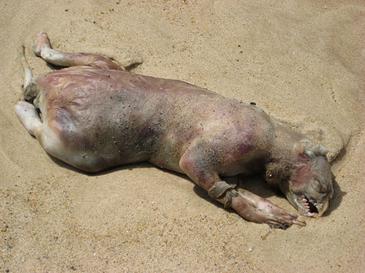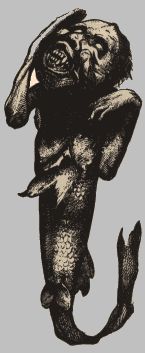Place: Ramsay LT, Christopher Ingold Building, University College London
UCLU ASHS gathered on this rainy Thursday night for a talk on mermaids, the Montauk Monster, and Japanese Monkeyfish, amongst other dubiously existing creatures introduced to us by Paolo Viscardi. As a natural history curator at the Horniman Museum in South London, co-founder of London Science in the Pub, and administrator of askabiologist.co.uk, Viscardi presented numerous examples from both history and his own experiences of the evolution of myths, memes, and misidentifications in society, demonstrating how "members of the public are freaks."
 With an educational background in biology and geology, Viscardi applies his knowledge of fossils and bones in his work at the Horniman Museum. As such, he frequently receives inquiries from laymen finding ambigious-looking objects around the country requesting their identification (or confirmation of wacky suspicions, rather), of which he listed several examples: a concreted sea urchin believed to be a dinosaur egg; the all so familiar random toast burns believed to be the manifestation of Jesus and its Muslim equivalent; the Pope in a fire; and the 'polar bear' washed up on the beach in Cornwall. These are all examples of pareidolia, people's tendency to assume things are 'super freaky' because it looks different or has certain features, reflecting the intrinsic human ability to search for and attribute meaning to ambiguous stimuli. When taken to the extreme, pareidolia can also reflect human idiocy, as it were, exemplified by the case of the man who was so convinced the piece of rock he had found was a dinosaur egg containing an embryo, that he kept it for over 20 years and staked his entire retirement on it.
With an educational background in biology and geology, Viscardi applies his knowledge of fossils and bones in his work at the Horniman Museum. As such, he frequently receives inquiries from laymen finding ambigious-looking objects around the country requesting their identification (or confirmation of wacky suspicions, rather), of which he listed several examples: a concreted sea urchin believed to be a dinosaur egg; the all so familiar random toast burns believed to be the manifestation of Jesus and its Muslim equivalent; the Pope in a fire; and the 'polar bear' washed up on the beach in Cornwall. These are all examples of pareidolia, people's tendency to assume things are 'super freaky' because it looks different or has certain features, reflecting the intrinsic human ability to search for and attribute meaning to ambiguous stimuli. When taken to the extreme, pareidolia can also reflect human idiocy, as it were, exemplified by the case of the man who was so convinced the piece of rock he had found was a dinosaur egg containing an embryo, that he kept it for over 20 years and staked his entire retirement on it.The Montauk Monster, in particular, is a case of mistaken identity which received widespread attention. A 'weird alien monster creature with a beak' washed up on the shore of Montauk, spawning a cult movement including Montauk Monster artwork, websites, origami and Montauk Monster on toast, before the truth was finally revealed as retold in this video. Instead of indulging in this the hysteria of pareidolia, Viscardi urged us to look at the Monster's teeth, as teeth are very good indicators of the species. Showing us images of the Montauk Monster's skull next to four comparable skulls of North American mammals, the audience unanimously correctly identified the Monster's skull as that belonging to a raccoon. Its carcass had been in water for such a long time that it had lost all its fur, thus giving it its otherwordly appearance.
 Viscardi described further examples of such mistaken identities and manufactured monsters. Travellers, including Christopher Columbus, encountering the then unfamiliar species of manatees and dugongs, would often think they were mermaids. Stories of mermaids have been around for thousands of years, and there is a large body of folklore and myths surrounding these mythological creatures. Naturally, then, sailors knew much more about mermaids than manatees and dugongs. This, coupled with likely mental disturbances, such as hallucinations, caused by long travels, would lead the sailors to believe these squishy creatures were mermaids.
Viscardi described further examples of such mistaken identities and manufactured monsters. Travellers, including Christopher Columbus, encountering the then unfamiliar species of manatees and dugongs, would often think they were mermaids. Stories of mermaids have been around for thousands of years, and there is a large body of folklore and myths surrounding these mythological creatures. Naturally, then, sailors knew much more about mermaids than manatees and dugongs. This, coupled with likely mental disturbances, such as hallucinations, caused by long travels, would lead the sailors to believe these squishy creatures were mermaids.It goes without saying that the phenomenon of pareidolia can easily be exploited for personal gain. Mermen, or Japanese Monkeyfish, were believed to be manufactured by sewing the upper half of a monkey to the lower half of a fish. P.T. Barnum was a notable scam artist who in the mid-1800s misrepresented the so-called 'Fejee Mermaid' with a rich 'background story', 'verification' of authenticity by a 'Dr Griffith' and clever manipulation of newspaper journalists. This caused great uproar among the public, generating substantial sums of money for Barnum. Years later, a Japanese Monkeyfish arrived at the Horniman Museum. CAT scans, x-rays and other examinations revealed the 'part fish, part monkey' to be constructed by a piece of wire, some pieces of wood, a bundle of fiber, some fabric, clay, papiermaché and some fish bones.
In conclusion, then, 'always check your facts, otherwise you'll end up looking like an arse.' Also, there are lots of weirdos out there.
Check out Viscardi's blog for Friday mystery objects or visit the Horniman Museum (supposedly wonderful in the summer for picnic with mates!).



No comments:
Post a Comment